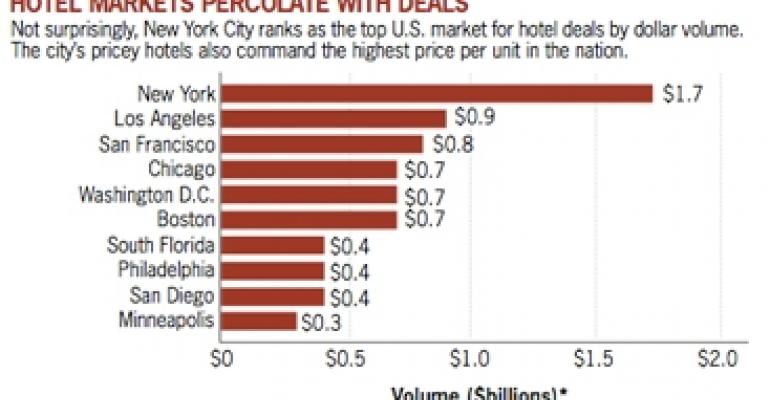As the chairman and CEO of Prime Group in Chicago, Michael Reschke has been known for years as a developer of office towers and shopping centers. For now, however, he’s sinking his money into hotels, opening a 610-room JW Marriott in his city’s business district just before Thanksgiving, at a mountainous cost of $360 million. Next up, Reschke is planning a smaller 240-room hotel two blocks away in partnership with Ian Schrager.
“I got started in planning for the JW Marriott back in 2007, just before the market collapsed,” says Reschke. “I feel lucky that now that it’s opening the industry is fully back on the road to recovery. I expect to be looking for more hotel opportunities in the future.”

Investors and developers are following Reschke into the market, signaling a buoyant environment for lodging sector transactions in 2011 as a recovering travel industry fills up rooms again. The trend is obvious: In the quarter that ended Sept. 30, U.S. hotel sales reached $2.7 billion, a fourfold increase over the same quarter in 2009, according to data from Real Capital Analytics. For the first nine months of 2010, sales of full-service properties had more than doubled to $5.6 billion.
In gateway cities, prices also are on the rise. The private-equity specialist Angelo Gordon & Co. paid a breathtaking $1.05 million per room, or $166 million, to acquire the boutique 157-room Helmsley Carlton House in New York. Host Hotels & Resorts paid $686,000 per room, or $185 million, to buy the 270-room W Union Square in Manhattan. Dealmaking recently has involved strategic hotel operators and private-equity investors.
“The market has changed dramatically from a year ago, when it was anemic everywhere,” declares Arthur Adler, CEO of the Americas at Jones Lang LaSalle (JLL) Hotels. His firm entered 2010 with the forecast that U.S. hotel transaction volume would reach $4.5 billion. Now JLL expects the year to end at $10 billion or more. “With the debt market emerging again, transaction volume almost certainly will climb higher in 2011,” says Adler.
Sandra Kellman, co-chair of the global hospitality and leisure practice group at law firm DLA Piper in Chicago, reveals that her team closed three hotel sales in all of 2009. This year, the team participated in nine sales in August alone. “New debt is creeping into the market and we’re seeing an amazing turnaround in dealmaking,” says Kellman.
Improved operating metrics have propelled the turn. The U.S. hotel occupancy rate nationally averaged 57.9% year-to-date through October, up 11.7% from the same period a year earlier, with daily rates up 0.7% to almost $100, reports STR Analytics. Revenue per available room (RevPAR) rose a remarkable 12.5% to $57.76. In the broad-based recovery, room occupancies rose nearly 25% in Detroit and 24% in Orlando. RevPAR in Washington, D.C. shot up 34% followed by a 29% gain in Minneapolis/St. Paul.
David Loeb, a hotel analyst with brokerage house Robert W. Baird & Co. in Milwaukee, points out that the fundamentals look better than they are. “Keep in mind that all these increases are based on comparisons against the numbers at the depth of the downturn in 2009,” he says. Nonetheless, Loeb believes that investors will dive into the market, and real estate investment trusts (REITs) will have the upper hand in bidding for assets early next year. But private-equity groups will be active too, and are likely to find loan-to-value financing at 60% to 65% in 2011, the most leverage they’ve been able to garner in several years. “At 65% leverage the private-equity guys can afford to become quite aggressive,” says Loeb.
One private-equity firm, the Brilla Group in Miami, recently paid $30 million for the 105-room Art Deco masterpiece Raleigh Hotel in that city’s South Beach. Brilla also is landing deals in the Caribbean. “For now, it’s still much cheaper to buy a hotel than to build one from the ground up,” says David Brillembourg, Brilla’s CEO. But deeply discounted assets are becoming harder to find, he says.
Still, the construction pipeline continues to shrink. In the second quarter of 2008, 1,723 hotels were under construction in the U.S., according to Lodging Econometrics in Portsmouth, N.H. By the third quarter this year that total had fallen 72% to 487. “We still haven’t hit bottom,” says Patrick Ford, president of the research firm. “We continue to be far off the operating peaks we were at a few years ago,” Ford says. “This recovery still has a long ways to go.”

